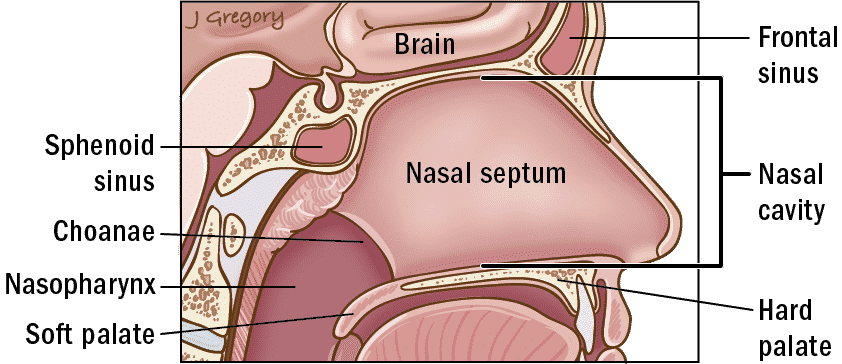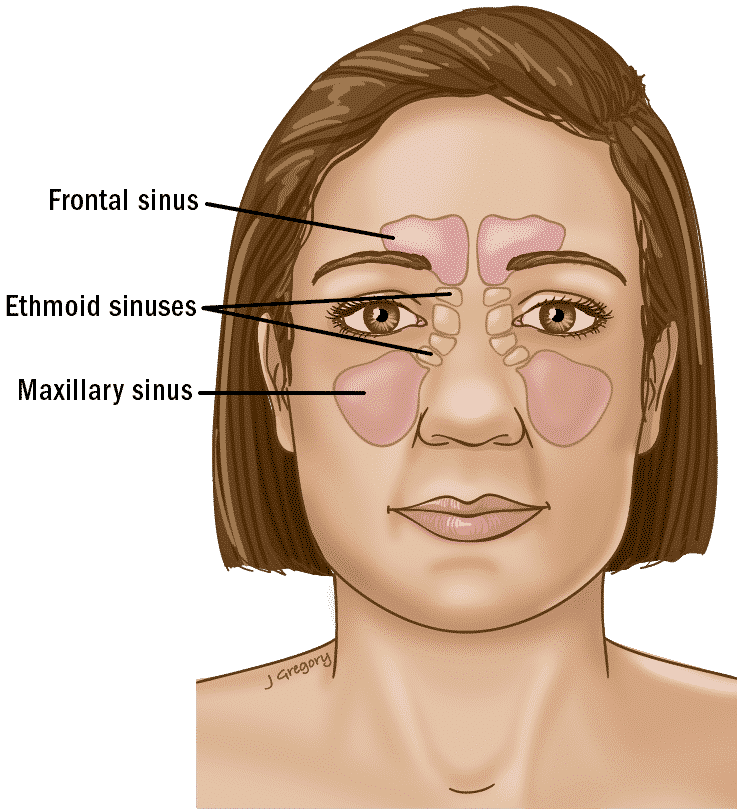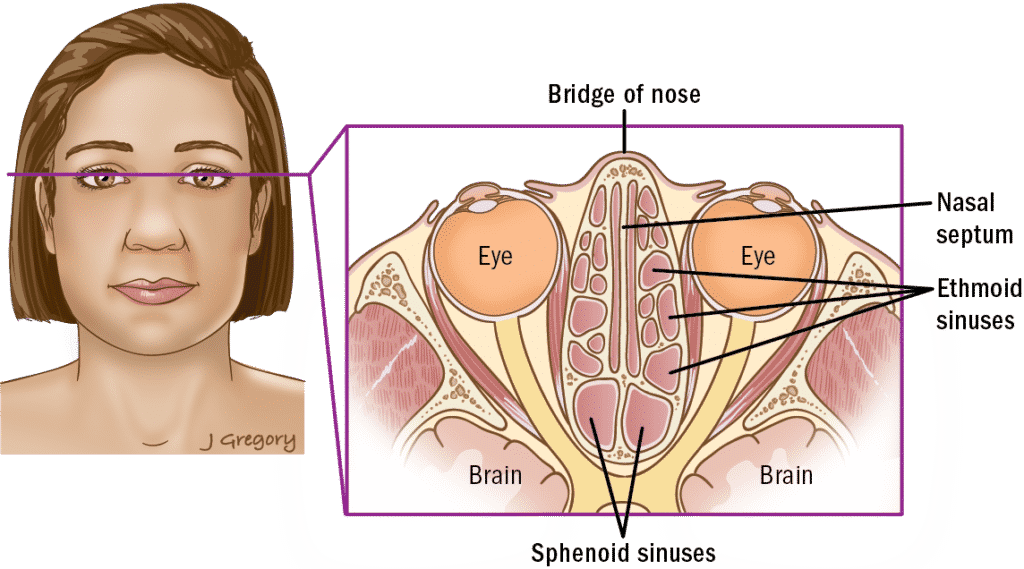In order to understand nose & sinus cancer, it is important to gain some background knowledge on the anatomy of the region, which includes the nose, nasal cavity, and sinuses. The inside of the nose, called the nasal cavity, is much bigger than it seems and contains many different structures, or subsites. The left and right nasal cavity are separated by the nasal septum. The very back of each nasal cavity connects to the nasopharynx through two openings, one on either side, called the choanae. The nasopharynx is an open part of the back of the throat that connects both sides of the nasal cavities with the oropharynx.
It is important to remember that cancers on the skin on the outside of the nose and cheeks are considered skin cancers, that have the capacity to invade deeply into the nose and sinuses and can overlap with various aspects of the discussion that follows, but will not be covered in this section.
Nasal Anatomy
The 4 Main Subsites of the Nasal Cavity
- Vestibule
This is the inner nostril. It starts at the very edge of the outer skin of the nostril and stops where the skin transitions into the inner mucous membrane of the nasal cavity. - Septum
This is the wall in the middle of the nose that separates the left nasal cavity from the right nasal cavity. It is made up of cartilage and bone. At the top of the nose, it joins with the bones of the skull. - Floor
This is the bottom part of the nasal cavity. It extends all the way to the back of the nasal cavity, where it meets the nasopharynx. - Lateral wall
This is the sidewall of the nasal cavity. It contains structures called turbinates (also called conchae), which are responsible for filtering and humidifying the air that comes through the nose. There are inferior (lower), middle, and superior (upper) turbinates. Sometimes there is a fourth, even higher, turbinate, which is called the supreme turbinate. Sinuses open into the nasal cavity through openings in the lateral wall just under the middle turbinate, and the tear duct drains tears that pass down from the eyes, through an opening in the lateral wall just under the inferior turbinate.

Sinus Anatomy
The sinuses, also called the paranasal sinuses, are air-filled spaces in the head that produce mucus. They are located near many important structures in the face and the bones of the skull that envelop the brain. There are 4 different types of sinuses that all come in pairs (one on the right side and one on the left side of the face):
- Maxillary sinuses
These are the cheek sinuses. They are located above the teeth, below the eyes, and next to the nose. Each maxillary sinus has a small hole that allows the mucus made in the sinus to drain into the nasal cavity, just under the middle turbinate. The maxillary sinuses are the biggest sinuses, and are also the most common site for sinonasal cancers. - Ethmoid sinuses
These are a group of 10-20 small sinuses that sit between the eyes and the nasal septum on both sides. There is a very thin piece of bone that separates the eye (actually the orbit) from the ethmoid sinuses. These sinuses have very thin walls, and the mucus they produce drains into the nasal cavity under both the middle and superior turbinates. The ethmoid sinuses are tied with the nasal cavity as the second most common site of sinonasal cancer. - Frontal sinuses
These sinuses are located behind the forehead and over the eyes. The mucus they produce drains into the nasal cavity through a passageway called the nasofrontal duct, which opens up just below the middle turbinate. - Sphenoid sinuses
These sinuses are located behind the nose at the base of the skull. Many important structures, including the brain, the nerve that controls vision, and the main blood vessel to the brain (the carotid artery) are all located adjacent to the sphenoid sinuses. The mucus produced by these sinuses empties into the nasal cavity just below the superior turbinate.


The Purpose of the Sinuses
The exact function of the sinuses is not entirely understood, but they have a variety of roles.
- Producing mucus that moisturizes the inside of the nasal cavity.
- Humidifying the air.
- Keeping the head light in weight.
- Allowing the voice to resonate.
- Potentially protecting the skull from damage due to hits or falls.












